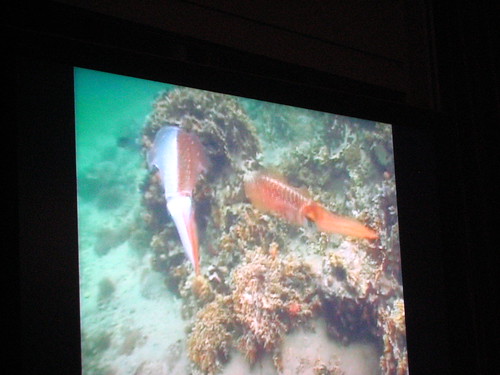Dr. Dave Gallo of the Woods Hose Oceanographic offers a quick and astounding tour of coloration of sea animals. He points out that we’ve explored only 3% of the deep ocean, finding underwater lakes, waterfalls and more diversity of life than tropical rainforests. Most amazing in his quick tour are cephalopods, which can control their coloration and texture to give them astounding camoflauge. We see a squid try “the moving rock trick”, where it mimics a piece of coral and uses currents to sneak up on prey. The squid above is courting – it’s whte on the right (the color of anger) to scare off other males, and brown on the left to attract the female. We watch an innocent patch of coral, which turns out to be a squid in hiding – it gets spooked, turns white, explodes away in a flash of ink, and gets a standing ovation from the TED crowd.

Paul Rothemund’s work is on a much smaller scale, but is also visually impressive. He talks about his work in terms of “magic incantations” – if we pass a magic incantation to a computer – a compiled programming language – the machine does our work for us. If we want to build things in the real world, we might use DNA – but we don’t yet have a compiler for proteins. Rothemund is coding proteins by hand and encouraging them to bend into arbitrary shapes. This involves writing a DNA sequence, sending it via email to a sequencing lab, getting strands of DNA back and using them to bend viral DNA into new shapes. He’s now able to make vials of microscoping stars amd smiley-faces out of DNA, with a 71% success rate. That’s cool, but it also points to the ability to create arbitrary micromachines made from DNA… and that’s amazingly cool.
